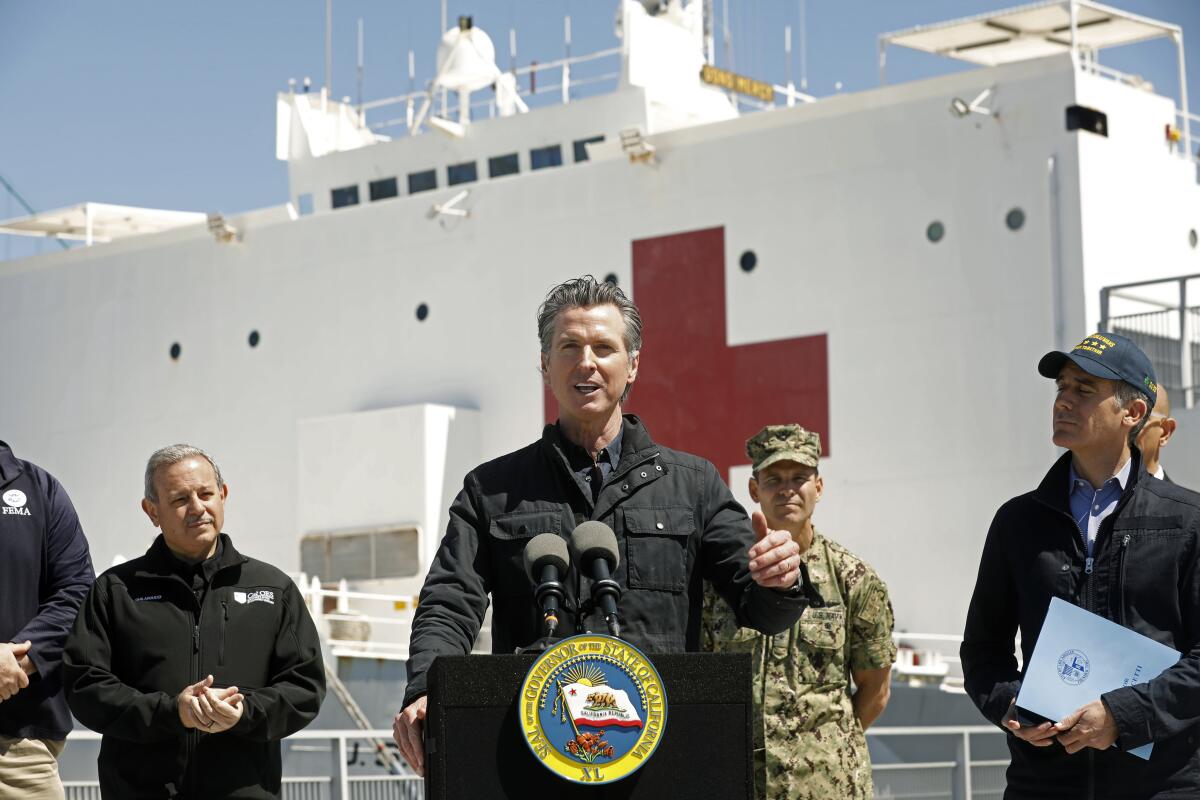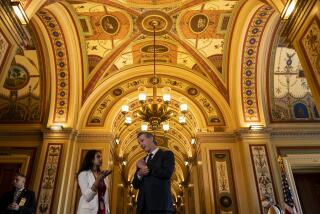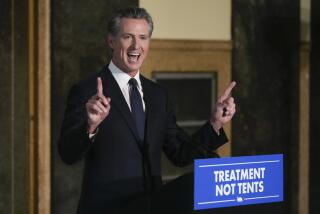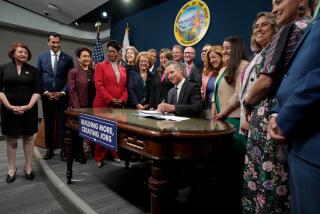Editorial: Gavin Newsom has been the leader California needs during coronavirus. But he can still do better

- Share via
It has become a pandemic staple: Every day at noon, Gov. Gavin Newsom stands before a camera, usually in the state’s emergency operations center, for a digital-age version of the fireside chat.
In his trademark stream-of-consciousness style, Newsom delivers an overview of the coronavirus’ effects on the Golden State to thousands of people watching on social media or tuning in on TV. He gives the grim tally of confirmed COVID-19 cases, hospitalizations and deaths, outlines the latest steps by state government to help Californians cope, and assesses what’s going on in the state that day. The governor uses no script during these daily briefings, riffing extemporaneously as if he’s live-streaming all the data, facts and figures he’s absorbed over the last 24 hours of meetings and reports. More often than not, he breaks a bit of news.
For the record:
11:08 a.m. May 11, 2020This editorial incorrectly states that Geogia, which has more than half as many COVID-19 deaths as California, has only a tenth of California’s population. Georgia’s population is about one fourth of California’s.
This is the Newsom the outside world sees: a calm, confident and intelligent (and verbose) governor handily guiding his massive state through an unprecedented crisis, informed by science and a sincere desire to protect the public’s health. Newsom’s tone of tough-but-necessary action has been consistent from the start, in stark contrast to the bumbling, confusing messages from the White House.
Behind the scenes, however, the governor seems to be operating at the same chaotic pace that characterized his first year in office, when he tried to do 5 million things at once and often had to backtrack on public pronouncements. And it has played out the same way in the pandemic, with Newsom making missteps that undermine his otherwise impressive performance over the last three months.
There is no guidebook for managing a state through a crisis of this magnitude, and every governor should be afforded some leeway in the mad scramble to make the right decisions without the benefit of precedent. And that goes double for the governor of a state as massive, as diverse and as demanding as California. Even in stable times, it’s a difficult state to manage.
Our purpose is not to quibble over stumbles by a well-intended and competent governor, but to suggest how he might do better in the coming months. California is facing a massive budget deficit, an ongoing economic crisis and a pandemic that’s likely to be around to some degree for years to come. The state needs the best from Newsom as we move out of the emergency response phase and start putting California back together for the long haul.
So let’s start with what Newsom has done right.
It’s not an exaggeration to say that there are people alive today because of Newsom’s expeditious action. His aides say he began monitoring the outbreak unfolding in China in January, aware of its potential impact on California from having governed through the SARS coronavirus outbreak in 2003 as a San Francisco county supervisor and the 2009 swine flu pandemic as mayor. In March, while President Trump was still dismissing the new coronavirus as no real threat to Americans, Newsom ordered non-essential businesses to close and Californians to stay at home to slow the spread of the disease it causes, COVID-19. At the time the closures may have seemed extreme, but they turned out to be prescient. In April, medical examiners in Santa Clara County revealed that the new coronavirus had been circulating, and killing people, in California weeks before initially thought.
As a result, California is faring much better than states where governors were slow to take pandemic precautions. Georgia’s Gov. Brian Kemp comes to mind. Kemp was one of the last governors to issue a stay-at-home order for his state and one of the first to allow businesses to reopen. Now, Georgia has become a COVID-19 hot spot, with 1,395 deaths as of Friday afternoon. That’s more than half of the deaths California has logged in a state with one-tenth the population.
We were also grateful that Newsom has suspended his role as Twitter foil to President Trump. He seems to have recognized that there’s little political gain in calling out the president’s gaffes when the state desperately needs federal assistance in obtaining pandemic supplies and filling a predicted $54-billion budget deficit.
Indeed, Newsom has made a point to praise Trump where appropriate, such as when the president sent a Navy medical ship to Los Angeles to treat patients if the state’s hospitals became overwhelmed. (They didn’t.) When the federal government sent California 170 broken ventilators, Newsom didn’t slam the feds, but figured out how to get them fixed.
Newsom has also picked up the leadership slack left by the Trump administration. In April, he announced that he would leverage the state’s relationship with manufacturers and its sizable (if quickly depleting) budget to buy millions of medical-grade face masks each month. He and the governors of western states have banded together to share best practices and confer on strategies to reopen businesses in their states.
Newsom’s strength has always been the ability to take the broad view and to dive into big initiatives. He’s said more than once that he’s not interested in the process of governing but in the outcomes. So it’s no surprise that his stumbles during the pandemic stem from improper attention to the process. Here’s a telling example:
The first weekend in May was expected to be another hot one in Southern California, with people venturing to the beaches for a bit of cool air as they had the weekend before. But then law enforcement agencies reported that the governor was planning to close all the state’s beaches on May 1 to prevent groups of people from gathering and potentially triggering more coronavirus outbreaks. Local officials reacted quickly, asking that he not punish the entire state for the crowding reported at some Orange County beaches.
The next day, the governor claimed he never intended to close all the beaches, and was in fact only targeting Orange County. And the memo police agencies said they’d received from his office? It “never got to me,” he said. That explanation did no favors for Newsom’s credibility. It was also perplexing. What’s wrong with having a change of heart after receiving new information and input from the public? That’s what we want our elected officials to do.
Inattention to process was also a factor in a number of other pandemic-related initiatives the governor touted before all the details were in place. One example was the governor’s announcement on April 24 of a plan for idled restaurants to provide three free meals a day to home-bound seniors, a win for both businesses and at-risk residents. The program would be administrated by local officials, he said, which surprised many local officials who had no idea such a program was in the works, according to a report by CalMatters. Thousands of people quickly signed up for the service, but have yet to receive meals.
Both Democratic and Republican legislators have complained that the governor fails to keep them in the loop or provide details about spending. They were particularly concerned about a ballyhooed $990-million deal with the Chinese electric car company BYD to buy millions of medical-grade masks, and it took weeks for the governor’s office to share the contract’s specifics. The state constitution grants the governor wide executive power to respond to emergency situations, but it doesn’t relieve him of accountability.
And local elected officials often find out about policies that would affect them at the same time as the public, such as when Newsom said last month that schools might open as soon as July. It was a surprise to some local superintendents, who were still working on how and when they might safely reopen their schools. And when Newsom noted in early April that he was going to send 500 ventilators to other states, it caught Santa Clara and Riverside county officials off guard. They were still madly scrambling to secure ventilators for their hospitals; in fact, Riverside had been denied a request for state-provided ventilators.
Senior administration officials defend what may seem like premature announcements and inadequate communication as simply the cost of rushing to launch so many new initiatives quickly in a bureaucracy that generally moves at a glacial pace. Better to go too fast to help people who are hurting, they say, than to move too slowly.
That’s a fair point. But as we’ve seen from several of the governor’s misfired initiatives, laying the proper groundwork for big new policy shifts is essential to the success of those efforts.
In any case, these are minor missteps that could reasonably be chalked up to an ambitious, impatient, multitasking governor who is operating, as they say, without a net. But as we move into phase 2 of the pandemic response, Californians need to see a steadier hand on the controls. Newsom should slow down a bit and attend to the important processes of governing as he leads California through one of the most challenging periods in modern history.
More to Read
A cure for the common opinion
Get thought-provoking perspectives with our weekly newsletter.
You may occasionally receive promotional content from the Los Angeles Times.










